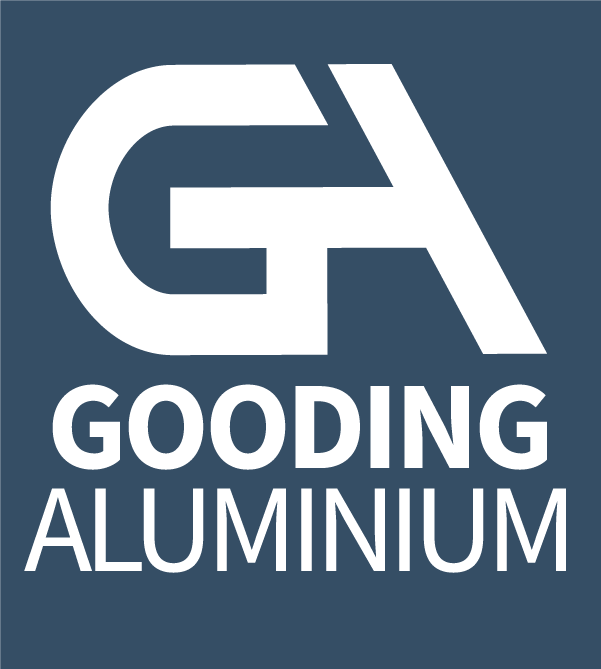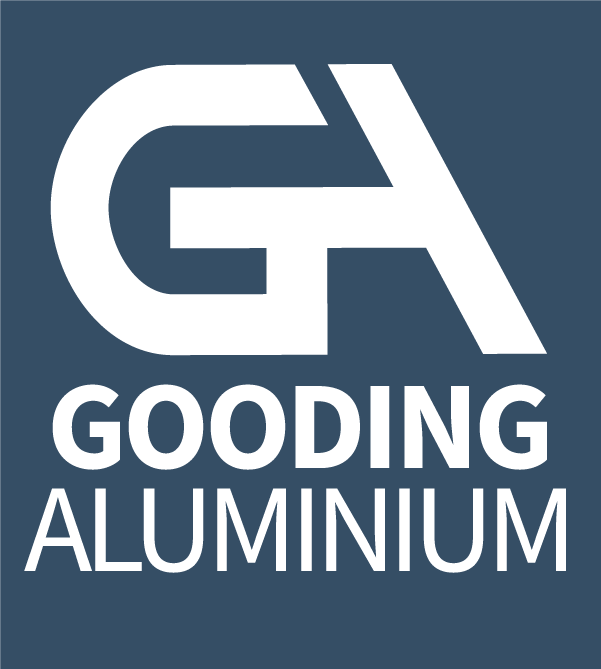A
Acute angle: A two-sided section with equal or unequal legs joining at less than 90° to each other.
Ageing: The hardening process which either takes place naturally at room temperature over a period of time, or by heating for a much shorter period at a relatively low temperature (known as artificial ageing).
Annealing: A thermal treatment for softening aluminium.
Anodising: The electrolytic process which thickens the natural oxide film on the surface of aluminium. The finish results in enhanced durability, weather resistance and appearance.
Anodised natural finish: A matt silver finish (without the addition of coloured pigments).
Anodised silver finish: A different description of the above finish.
Architectural quality: A grade suitable for the anodising process.
B
Base thickness: The thickness of a tread grip plate not including the lozenge height.
Blank: A sheared to size piece of metal.
Billet: The short slug of aluminium used in the extrusion process.
Box section: A square section with a square hollow centre.
Buffing: A mechanical finishing operation carried out with fine abrasives to produce a lustrous effect.
Busbar: A metal / grade with excellent electrical conductivity properties.
Burr: The thin ridge or area of roughness left by a metal shearing operation.
Butt strap: Used to join two end pieces of metal together.
C
C or U section: A three sided channel with legs or upstands at 90° to baseline.
Carrier bar: Usually a section of angle or flat bar rear fitted to and joining together a number of horizontal profiles e.g. louvre blades.
Chair section: A small ‘h’ shaped profile.
Chamfer: An angled edge.
Chemical brightening: A treatment to improve surface reflectance.
Chequer pattern: Describes a sheet / plate with an upraised lozenge pattern on one side, resulting in a non-slip surface.
Chromating: Chemical conversion process which acts as a surface pretreatment for improved corrosion resistance and paint adherence.
Clean: The mechanical removal of an upraised weld-bead.
Coil anodising: Coiled material is unrolled and passed through the anodising plant in one operation, achieving close control of surface shade and finish.
Cold working: Altering the metal shape or dimensions at atmospheric temperature.
Corner protectors: Normally a 90° right-angle section fixed to exposed wall corners for added protection.
Corrosion: The combination of metal with corrosive agents and the subsequent wasting away of the metal.
Corrugated: Profiled sheet formed to numerous ribbed and curved designs.
Crazing: The surface condition arising from forming pre-anodised material.
Crimp: To fold and pinch two pieces of metal together in making corners.
D
Deburr: The removal of sharp or irregular edges.
Dead lengths: Exact lengths within established tolerances.
Die: A round steel plate containing a cut out of the required profile shape, which the aluminium is forced through.
Die line: A longitudinal depression or protrusion formed on the surface of extruded sections. Die lines are visible to a degree on all extrusions and are caused by a wearing of the die bearing.
Dimensions: The measurements of any aluminium item are always taken to be the overall or outside dimensions unless otherwise stated.
Dowel: Solid round bar or pin cut to the required length.
Ductility: The property of metal which allows it to be deformed cold without fracture.
Duralumin or Dural: Generic terms used to describe medium strength aluminium alloy.
Durbar: A trade name for aluminium treadplate.
E
Edge: The side of an item.
Edge – sheared: The edge produced by the cold shearing of metal between two moving blades or between one moving blade and fixed edge.
Edgewise bow: The bow in sheet or strip which often occurs, to a lesser or greater degree, after shearing, usually measured in terms of offset from a straight edge.
Electrolytic polishing: Polishing effected by immersing the object to be polished in a suitable tank while an electric current is passed between the object and a cathode. The object to be processed is the anode and is polished by loss of its surface atoms.
End: The edge of the longest dimension.
Etching: The production of a matt finish by chemical (acid or alkali) treatment.
Expanded: Incised sheet material which is stretched into diamond or elongated shapes.
Ex-stock: From stock with immediate availability.
Extrusion – direct process: At high pressure an aluminium billet is pushed through a die with an aperture of the required shape (the majority of sections are extruded this way).
Extrusion – indirect process: At high pressure an aluminium billet is pulled through a die with an aperture of the required shape (miniature and intricate items are produced by this method).
F
Fabrication: The process of manufacturing to detailed requirement.
Face: The front surface of an item.
Finger plate: Usually a rectangular piece of flat sheet, screwed or bonded around the handle area of a door.
Fishplate: A flat piece of metal butt-joining one length to another.
Fishtail: A flat piece of metal splayed and slit at one end to facilitate keying into brickwork / concrete, etc.
Flange: Projecting upstand/s or leg/s on a section of profile.
Flashings: Normally factory-formed pressings to desired size and shape requirements for use as weatherproofing material on parapets, etc.
Form: An item produced by bending sheet material to the required shape, resulting in radiused or curved corners.
G
Gap: The inside dimension between two parallel flanges.
Girth: The overall width of an item.
Grain flow: Elongation of the grain structure in the direction of working.
H
H section: Identical in shape to a capital ‘H’ but with varying distances between the outside flanges to accommodate different board or glass thicknesses.
Heat treatment: An operation or combination of operations involving the heating and cooling of the metal for the purpose of obtaining certain desirable mechanical properties.
I
Ingot: The original form into which aluminium is cast for subsequent rolling or extruding.
J
Jay: Similar to an odd leg channel but with the baseline curving from the back leg to the front leg.
K
Kicking plate: Usually a rectangular piece of flat metal screwed or bonded to the full width of a door at floor level.
L
L shape: A two-sided section with equal or unequal flanges joining at 90° to each other.
Leg: Protruding flange or rib of section.
Louvre vents:
a) One-piece formed louvre, each louvre pushed out by a press tool.
b) Profile blades attached to surround frame or rear carrier bars.
M
Mill: Sheet or extrusion plant.
Mill finish: Raw aluminium, as it comes from the mill. Surface can vary from a dull to semi-bright appearance.
Moulding: Trim profiles produced in a malleable condition, suitable for cold forming.
N
Notch: A ‘cut out’ or ‘cut back’ from one end or edge.
O
Obtuse angle: A two-sided section with equal or unequal legs joining at more than 90° to each other.
Oddleg channel: Three sided aluminium section with one leg longer than the other but both joining the baseline at 90°.
Ovality: The departure of the cross section of a round tube or bar from a true circle.
Over pattern / over pattern thickness: Describes the overall thickness of a treadplate, including the lozenge height.
P
Part tool / die cost: Custom-made extrusions require a contribution towards tool / die production costs.
Patterned: A sheet product with a pattern, usually on one side, for decorative purposes.
Perforated: Sheet material with punched holes.
Plate: Rolled product with a thickness of more than 4.7mm.
Pitting corrosion: A localised condition on the metal surface, caused by reaction with atmospheric contaminants.
Polishing: The application by mechanical means of a grained or smooth surface.
Pop-rivetting: A mechanical means of joining from one side only, two pieces of metal.
Profile: The end / sectional view of an item.
Polythene / plastic film: A thin, peelable protective film, applied to sheet material before processing commences.
Q
Quenching: Rapid cooling of metal by immersion in oil, water or another medium.
R
Radius: A corner or edge with a rounded face.
Random lengths: Varying overall profile length.
Rip-saw: The cutting process which reduces or removes flange dimensions.
Rivet: A short metal pin for fastening two pieces of metal together, having a head at one end with the other end being hammered flat after location.
Rolling: Sheets or sections passed through a series of rollers to produce the desired shape.
S
SAA (satin anodised aluminium): Natural anodised aluminium.
Sealing: A treatment applied subsequent to anodising reducing the surface porosity.
Shate: Rolled products with a thickness of more than 3.2mm but no greater than 4.7mm.
Sheet: A rolled product with a thickness up to and including 3.2mm.
Sizes: All standard product dimensions are subject to the appropriate international tolerance standards.
Slab: A semi-finished aluminium product, approximately rectangular in shape, from which flat rolled items such as sheets, plates, etc. are produced.
Slitting: Cutting a strip into a number of narrower strips by means of rotary cutters.
Slug: The piece of material removed by the punching / perforating process.
Strain hardening / work hardening: Modification of metal structure by working at room temperature, resulting in an increase in strength / hardness, with a reduction in ductility.
Solution heat-treatment: Heating at a prescribed temperature for a given period of time, followed by a rapid cooling or quenching.
Split-batten: A narrow offset or jay type profile used for ‘invisibly’ hanging wall panels and boards.
Straightening: Correction of shape distortion by mechanical means.
Strip:
a) Sheet material sheared to narrow width.
b) An extruded flat bar.
Surface bloom: Aluminium surface discolouration, that can occur after prolonged exposure to moist air conditions or during heat treatment processes.
T
Table: The top plain surface.
Temper designation: The amount of work hardening or rolling an item has received.
Tolerance: The allowable deviation from a given dimension.
Top hat: A three sided channel section with extra flanges joining and facing outwards at 90° to each leg or upstand.
Tube: A circular section with a hollow centre.
W
Water bar: Flat strip or bar.
Wallboard section: Profiles designed to accept wall panels of varying thicknesses.
Water stains: Surface oxidisation, usually caused when moisture is present between closely stacked metal surfaces.
Web: The central part of a section that joins two flanges together.
Weld bead: The narrow moulding resulting from the welding process.
Wrought product: Items produced from the extrusion and sheet production processes.

